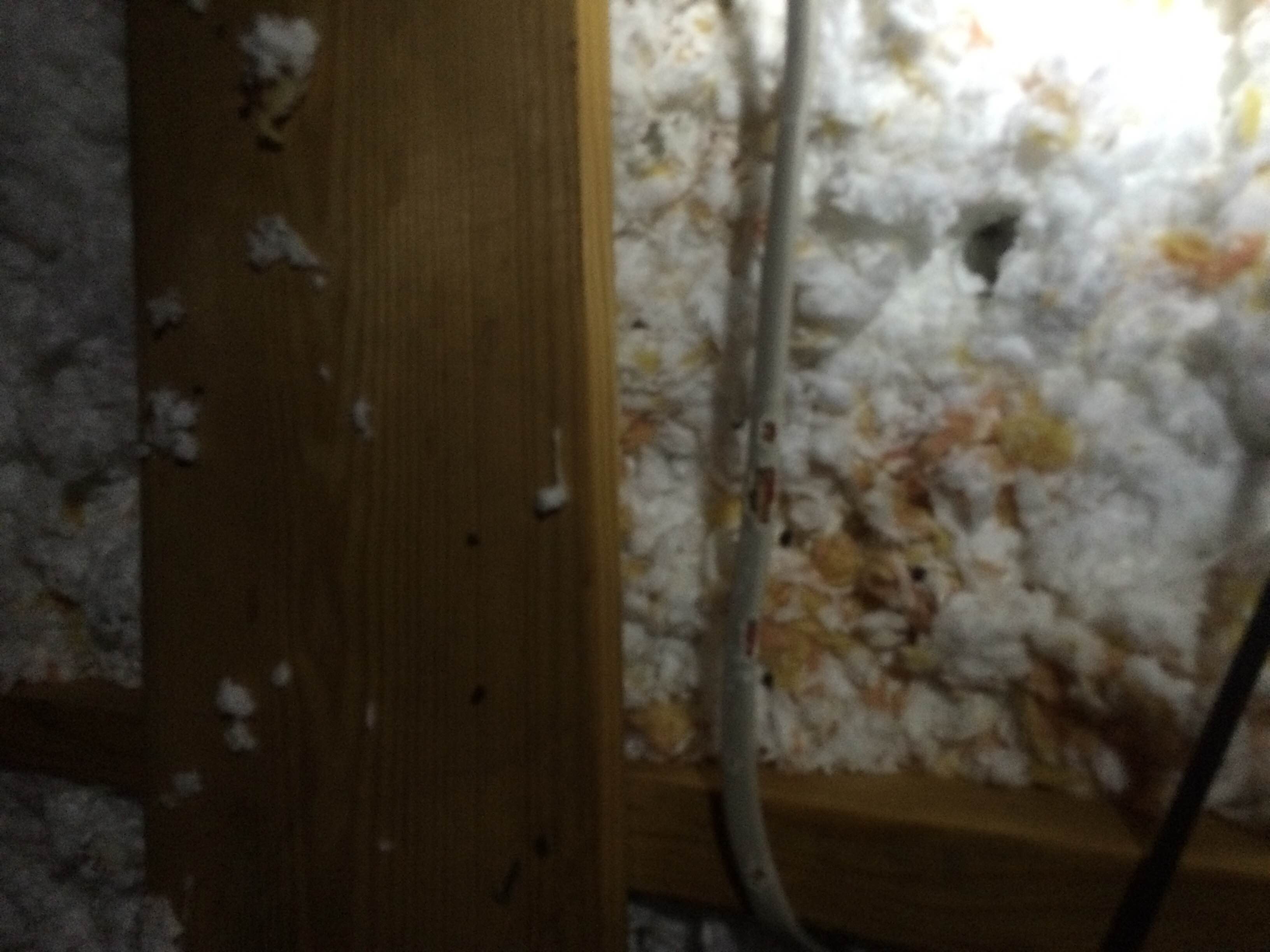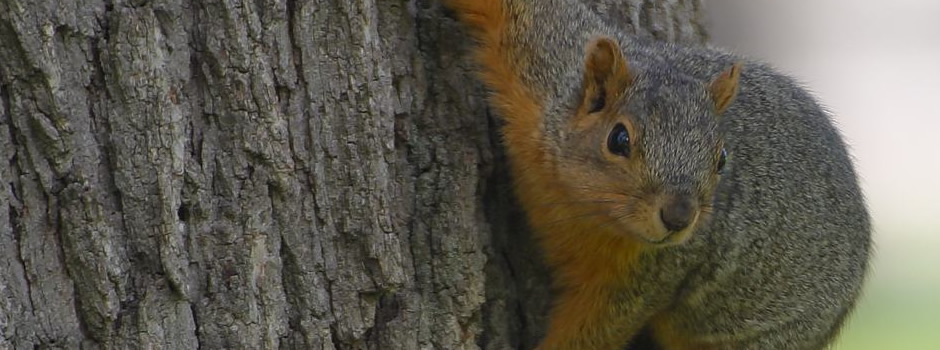Louisville Squirrel Removal
502-242-8195
 Squirrels may be cute, but they can cause a lot of damage to your home. Squirrel removal is needed before they create a big problem or decide to move into your home or business. They are known to easily jump from trees to roofs where they gnaw their way into attics and destroy insulation and drywall in order to make their nests.
Squirrels may be cute, but they can cause a lot of damage to your home. Squirrel removal is needed before they create a big problem or decide to move into your home or business. They are known to easily jump from trees to roofs where they gnaw their way into attics and destroy insulation and drywall in order to make their nests.
Experienced Animal Pros professionals will handle squirrel removal in a humane manner but will secure your building from future intrusions with squirrel exclusion. Louisville Animal Pros is multi-state certified, fully licensed, and insured. We have years of experience and BBB Accredited. The buck stops with us, as quality and customer satisfaction is held in the highest regard. Our permanent solutions give you peace of mind, knowing your problem is handled the right way.
Louisville Squirrel Control
Experienced Animal Pros professionals will perform an initial evaluation. We will set traps on site according to squirrel activity and the animals behavior. Every Squirrel control job is different. Our wildlife experts will inspect your home for nesting, damaged electrical wires from squirrel chewing, damage to air conditioning duct work, gnawing on wood surfaces, fecal accumulation, all openings, and will provide you a personalized inspection report detailing all of recommendations. We provide affordable options that get results. All repairs performed by Louisville Animal Pros are backed by a warranty you can count on.
Some of the squirrel nuisance concerns that you may encounter:
- Squirrels In The Attic
- Squirrels In A Wall
- Squirrels In A Vent
- Squirrels In The Soffit
- Squirrels In A Gutter
- Squirrels In The Insulation
- Squirrels In The Crawlspace
- Squirrels In Duct Lines
- Squirrels Chewed Electric Lines
- Squirrels Damaged Roof
- Squirrels Chewed A Hole In The Siding
- Squirrels Have A Nest In The Attic
- Squirrel Had Babies In The Attic
- Squirrel Droppings In The Insulation
- Squirrels In The Drop Tiles
- Squirrels In A Warehouse
- Squirrels On A Roof
Louisville Squirrels in the Attic
Squirrels in Your Attic? Once a squirrel has gained access into your home or attic, the chewing of electrical wires, insulation damage/contamination and noises will begin. Squirrel repellents and noise makers will not be effective you need squirrel trapping. The only way to permanently solve the squirrel problem, is to remove the squirrels with the natural behavior patterns of coming into your home, attic or chimney. Louisville Animal Pros wildlife experts know animal behaviors and patterns. Our proven solutions give you peace of mind knowing your squirrels in attic Louisville problem is taken care of permanently.
Squirrel Species
Squirrels in Kentucky consist of Grey Squirrels (Most Commonly Seen), Red Squirrels, Flying Squirrels, and the Fox Squirrels with variations in sizes between the species. Most of the damage caused by squirrels is relatively the same with teeth growing constantly and the need to keep their teeth filed down by chewing. Squirrels of varying species can cohabitate in an attic.
Grey Squirrels
Kentucky’s Eastern Grey Squirrel is the most common squirrel species in the state. They frequent most residential neighborhoods, acrobatically robbing bird feeders, running across roofs, and chewing and gnawing their way into attics. Grey Squirrels give birth twice a year, once in the spring, and again in late summer. Average litter is 3-4 young at a time. Grey Squirrel nests are easily spotted in winter, as leaves turn brown giving away their location. With the ability to jump at incredible heights, run up the side of homes, and adapt well in residential settings, they are causing problems everywhere. Interestingly the greatest tool of a squirrel is its tail, with the use of its tail for shade from the sun, balancing, as a umbrella, and even as a rudder when swimming.

Louisville Grey Sqiurrels
Flying Squirrels
Kentucky Flying Squirrels in reality do not fly, but rather glide through the air. Increasing in populations, there are certain areas in Kentucky that has Flying Squirrel problems. Flying Squirrels have young twice a year, once in spring, and again in late summer, and can have as many as 2-7 young per litter. Removal of Flying Squirrels should only be attempted from a professional, as they do have excellent homing abilities and can return. They are nocturnal in most cases, and active throughout the year.

Louisville Flying Squirrels
Squirrel Diseases
Disease information for Squirrels is not too much to worry about, except we had a confirmed case in Franklin, KY, of a homeowner contacting Leptospirosis from coming in contact with squirrel urine while in her attic pulling out Christmas decorations. The zoonotic disease came on much like the flu virus, and was dismissed as such until the effects started getting much worse prompting hospital treatment. While disease transmission is rare from squirrels to humans, it is possible in areas that contain fecal or urine accumulation and nesting. According to the Center For Disease Control, between 1976 to 2001 there were 39 human infections of Typhus Fever from Flying Squirrels or nests. In addition to diseases, a concern should also be to ectoparasites which includes fleas, ticks, mites, and even mosquitoes that have bitten a infected animal. A far greater concern than diseases or ectoparasites in squirrels, would be if you have squirrels in your attic, chewing on electrical lines.
Squirrels Chew Electrical Lines
 Squirrels are to blame for a estimated 30,000 house fires each year and millions in damages. Squirrels have caused power outages in cities and states nationwide, and with teeth growing 2″-3″ it is understandable why they have to keep them filed down by gnawing. Squirrels will chew on things in a attic, automobile, and even outside power lines. Why? To keep teeth filed down and to see if something is edible. We have created the perfect habitat with plenty of oak trees, shade, shelter, and even bird feeders, that squirrels have the knack of utilizing. Every State has been affected by Squirrel Chewing, causing Electrical outages, even Nasdaq, Airports, Businesses, and hundreds of thousand residents nationwide. Squirrels have surpassed the cyber hackers as the greatest threat to our electrical grid. The only permanent solution is to remove problem squirrels from the area. For Commercial clients, these situations require immediate assistance and urgency. Normal wildlife operators wont have 100 traps to bring out to a commercial squirrel job. We are available when seconds count.
Squirrels are to blame for a estimated 30,000 house fires each year and millions in damages. Squirrels have caused power outages in cities and states nationwide, and with teeth growing 2″-3″ it is understandable why they have to keep them filed down by gnawing. Squirrels will chew on things in a attic, automobile, and even outside power lines. Why? To keep teeth filed down and to see if something is edible. We have created the perfect habitat with plenty of oak trees, shade, shelter, and even bird feeders, that squirrels have the knack of utilizing. Every State has been affected by Squirrel Chewing, causing Electrical outages, even Nasdaq, Airports, Businesses, and hundreds of thousand residents nationwide. Squirrels have surpassed the cyber hackers as the greatest threat to our electrical grid. The only permanent solution is to remove problem squirrels from the area. For Commercial clients, these situations require immediate assistance and urgency. Normal wildlife operators wont have 100 traps to bring out to a commercial squirrel job. We are available when seconds count.
Understanding Squirrel Damage
If you have squirrels, and go in your attic, and make sure everything is out, and quickly go outside and repair the opening. You’re in the clear right? Wrong. Squirrels that have developed the natural behavior pattern of entering your attic, will keep that behavior pattern until the are removed from the area. A squirrel can literally chew a softball size opening in wood in a matter of minutes. If you have previously had squirrels removed, and the squirrels have came back, and re entered your attic, why did that not last? All wildlife communicates by scent markings. If you have ever seen a dog mark a fire hydrant, another dog smells the fire hydrant, that’s what i mean. Body oils that rub off a squirrels fur at the openings it is entering, or fecal and urine accumulation in a attic, nesting, these things are like a calling card to a squirrel. Squirrels will come back if any of these items are left in the area. That is why it is important to use a professional.
Question?: I have Squirrels in the attic, and live traps baited with peanut butter, because that’s what it said online, but have not had any luck. What am I doing wrong.
Answer: There are a few things initially i would change. Over the counter traps, or traps you buy at a local hardware store are usually not as sensitive as they should be for successful trapping. The trigger mechanism is usually to heavy to work optimally. Second thing is the bait choice. Not all squirrels will be crazy about peanut butter, or the squirrels may prefer the bird seed in the feeder outside, or there may be a abundance of oak trees in your yard, or traps are not in the right location. There are many aspects that are evaluated by our specialists to ensure successful trapping.
Question?: I see squirrels going in my attic, but when I go up in my attic I don’t see anything. Can you help me understand whats going on?
Answer: Squirrels in a attic can nest in the attic, but usually it will be in the soffit area, the drop down space from the attic, which is vented, but travels usually around the homes perimeter. Even when its hot in your attic, because the soffit is vented, its almost like the squirrel is outside, plus they can pull insulation down from the attic to make a suitable nesting location. I would place a trap as close to or on the opening the squirrel is entering or exiting.

